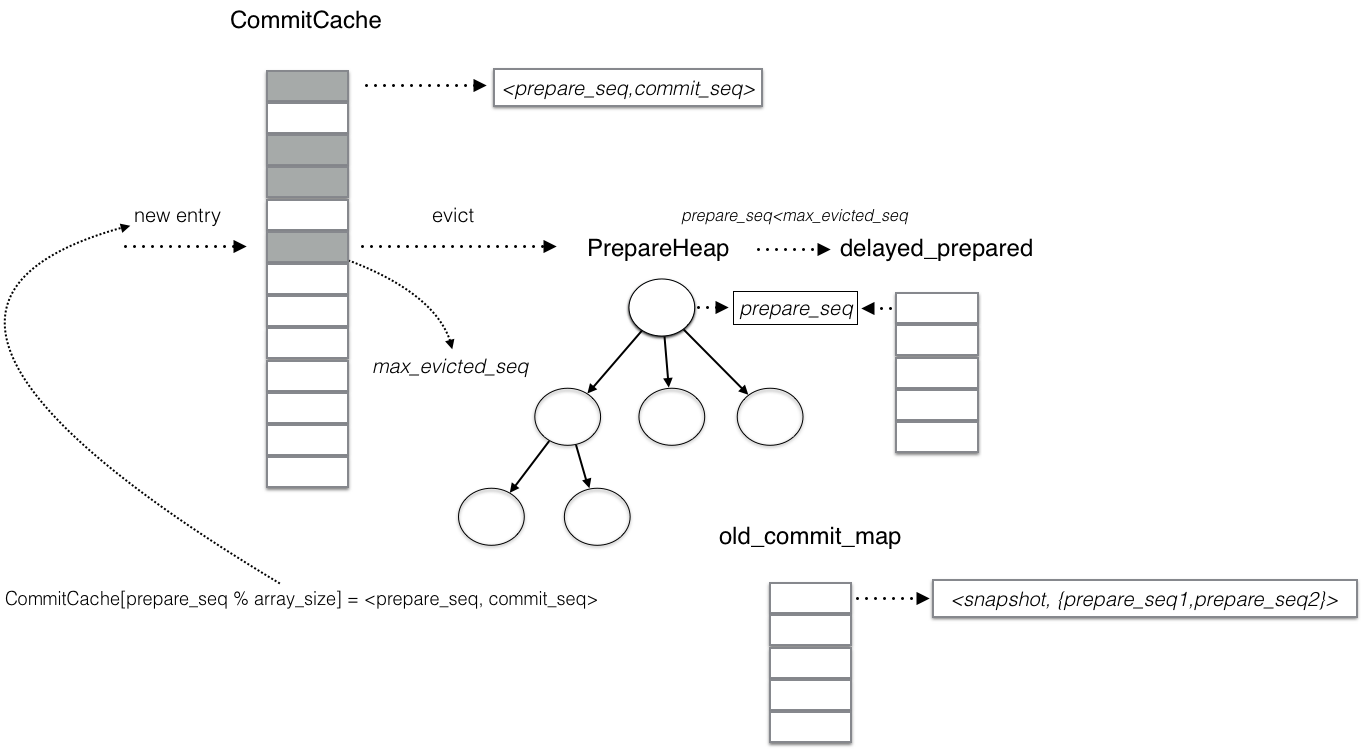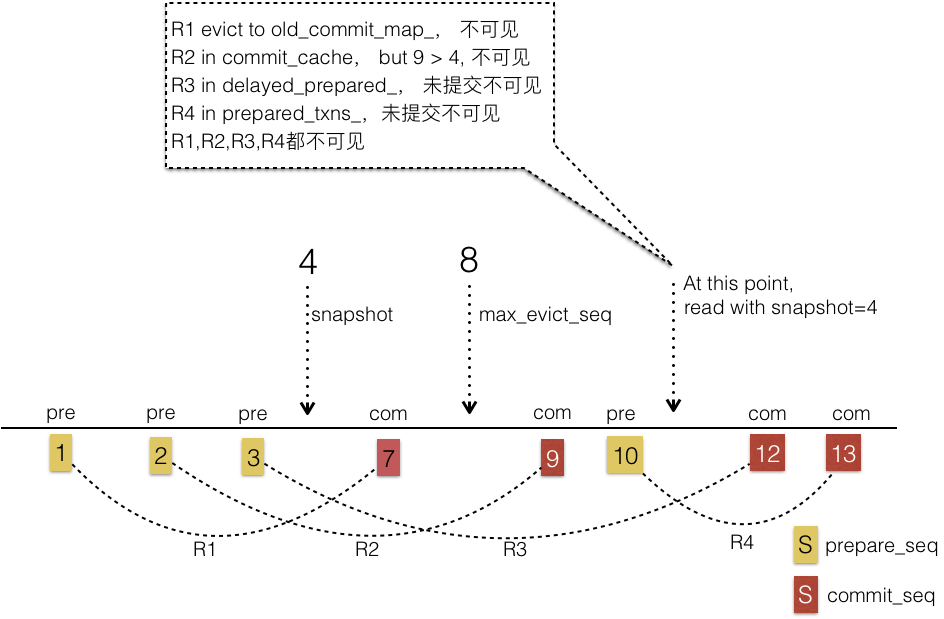MySQL · RocksDB · Write Prepared Policy
Author: 张远
背景
早期RocksDB TransactionDB将事务的更新操作都缓存在WriteBatch中,事务提交时才写WAL和memtable。RocksDB支持二阶段提交(2PC)后,在prepare阶段写WAL, WriteBatch写memtable依然在commit阶段。这种方式的优点是,事务隔离性比较好,当前事务看不见其它事务的未提交数据, 事务的可见性仅通过sequence大小即可判断,参考这里 , 另外事务回滚也比较简单,只需要释放WriteBatch即可。
但同时也存在以下缺点
- 事务提交操作比较重,延迟较大
- 事务都缓存在WriteBatch中,对大事务不友好
- 无法支持read uncommitted隔离级别
Write Policy
针对TransactionDB的以上缺点, rocksdb引入了新的提交策略(write policy), 共有以下write policy
-
WriteCommitted
即原有的方式,提交时才会写WriteBatch, 默认为WRITE_COMMITTED方式.
-
WritePrepared
将写memtable提前到prepare阶段。
prepare阶段写WAL, 并且写memtable
commit阶段写commit标记到WAL。 WritePrepared方式减轻了提交的操作,但并不能解大事务的问题。 -
WriteUnPrepared
将写memtable提前到每次写操作。 目前此方式还在开发中。 WritePrepared方式减轻了提交的操作,同时也能解大事务的问题。
本文主要介绍WritePrepared的实现方式。
WritePrepared问题
WritePrepared方式将写memtable提前到prepare阶段,会引入以下问题
-
写入memtable的记录如何判断可见性
WritePrepared方式记录中的sequence是在prepare阶段就分配的,对于某个snapshot来说,snapshot大于此sequence并不代表此记录对snapshot可见。 -
如何回滚memtable中的记录
不像WriteCommitted方式直接释放WriteBatch就可以回滚事务,WritePrepared方式回滚时memtable中的记录需要以一定的方式回滚
WritePrepared方式在prepare阶段写memtable时会分配sequece, 设为prepare_seq, prepare_seq会存储到记录上。同时提交时会记录一个sequence, 设为commit_seq,commit_seq并不存在记录上,通过commit_seq可判断记录可见性。
snapshot > commit_seq, 此记录可见
这里就存在矛盾了,能判断记录可见性的commit_seq并不存储在记录上
事务可见性分析
对于下图中,设记录的key是唯一的,对于snapshot=8来说,R1, R2两个记录是可见的,因为R1,R2的commit_seq都小于8。而R3,R4,R5的commit_seq都大于8,所以R3,R4,R5是不可见的。

在分析WritePrepared事务可见性实现之前,我们先来看看可见性最简单的实现方式
第一种方式
每个事务开始时, 获取当前已经开启但未提交的事务列表,称之为read_view. 在rocksdb中read_view为prepare_seq的集合, 其中min_seq 为read_view中的最小sequence, max_seq为readview中的最大sequence.
对于snapshot=S事务可见性规则如下:
- prepare_seq < min_seq, 事务在S前已提交,可见。例如上例R1
- prepare_seq > max_seq, 事务在S后开启,不可见。例如上例R5
- prepare_seq exist in read_view, 对于S来说,事务已经开启,但未提交,不可见。例如上例R3R4
- 其它情况,可见。例如上例R2
上例中read_view = {4,5}, min_seq=4, max_seq=5
这种方式不需要commit_seq. 但每个事务都需要维护read_view.
innodb 的可见性就是通过此规则来实现的
第二种方式
commit_seq并没有存储在记录中,我们可以在内存中维护commit_seq信息,假设我们将每个已经提交的事务信息对(prepare_seq,commit_seq)都存储起来称为commit_cache
对于snapshot=S事务可见性规则如下
- prepare_seq > S 不可见,例如上例R5
- prepare_seq exist in commit_cache, 通过对应的commit_seq判断是否可见, 例如上例R1,R2的commit_seq <= S 可见,而R3,R4,R5的commit_seq > S 不可见。
- prepare_seq not exist in commit_cache, 未提交事务,不可见。
上例中commit_cache = {<1,2>, <4,9>,<5,10>,<6,7>, <11,12> }
这种方式简单,但需要存储所有已提交的信息,不太可行。
WritePrepared 可见性实现分析
rocksdb WritePrepared的实现折中了以上两种方式。先介绍WritePrepared引入的一些数据结构
- commit_cache
commit_cache保存所有的已经提交的事务信息对<prepare_seq,commit_seq>, 但commit_cache会以CommitCache[prepare_seq % array_size] = <prepare_seq, commit_seq> 方式淘汰, prepared_seq是递增的,所以commit_cache的淘汰大体上是先进先出的, 这样commit_cache基本上保存的是最近提交的事务信息。
其中max_evicted_seq_记录淘汰出的最大的prepare_seq。
-
prepared_txns_
prepared_txns_是一个最小堆,保存当前prepare但未提交的事务。prepared_txns_在prepare时加入prepare_seq,在commit时踢除. -
delayed_prepared_
delayed_prepared_保存的是未提交事务。 Commitcache发生evict时, AdvanceMaxEvictedSeq推进max_evicted_seq_,prepared_txns_中小于max_evicted_seq_都踢除,并加入到delayed_prepared_. delayed_prepared_在commit时也会踢除, 小于max_evicted_seq_的未提交事务都在delayed_prepared_中
prepared_txns_和delayed_prepared_都是prepare的但没有commit的事务 也就是说当前prepare的但没有commit的,要么在prepared_txns_中要么在delayed_prepared_中
-
min_uncommitted_
min_uncommitted_事务开启快照时获取的最小未提交事务即prepared_txns_.top -
old_commit_map_
old_commit_map_存储snapshot对应的未提交事务列表. Commitcache发生evict时[pre_seq,commit], 存在某个snapshot, 如果满足prepare_seq < snapshot < commit_seq, 这个prepare_seq会加入old_commit_map_. 也就是说old_commit_map_只存储哪些被evict的事务,对应某些snapshot来说是不可见的。 事务提交ReleaseSnapshotInternal时从old_commit_map_移除

事务可见性判断以max_evicted_seq_为界, prepare_seq小于等于max_evicted_seq_时按第一种方式处理, prepare_seq大于max_evicted_seq_时按第二种方式处理。

- prepare_seq大于max_evicted_seq_
直接应用第二种方式的规则
- prepare_seq > S 不可见
- prepare_seq exist in commit_cache,通过对应的commit_seq判断是否可见
- prepare_seq not exist in commit_cache, 未提交事务,不可见
- prepare_seq小于等于max_evicted_seq_
基本上对应于第一种方式的规则
- prepare_seq exist in delayed_prepared_, 事务未提交,不可见
- prepare_seq < min_uncommitted_, 事务在S前已提交,可见。
- snapshot > max_evicted_seq, 事务在S前已提交,可见。
- prepare_seq exist in old_commit_map_, 对于S来说,事务已经开启,但未提交,不可见。
- 其它情况,可见。
WritePrepared 可见性判断还是比较高效的 prepare_seq大于max_evicted_seq_时可以通过commit_cache快速判断
prepare_seq小于max_evicted_seq_时又分为以下几种情况 prepare_seq < min_uncommitted可以快速判断可见 min_uncommitted 和max_evicted_seq_之间, 未提交的在delayed_prepared_不可见,提交的有一部分在commit_cache,前面已判断。 > 另一部分提交的已evict掉,通过Snapshot > max_evicted_seq_ 可以快速判断可见。 最后的就通过old_commit_map_来判断prepare_seq是否在某个live snapshot中
这种方式对长事务不友好,如果有一个很老的事务未提交,那么min_uncommitted 和max_evicted_seq_之前的区间会比较大,判断就比较低效
如果commit_cache比较大_(默认8M个entry), 且都是短事务的场景,这样基本可以保证新开启事务的Snapshot > max_evicted_seq, 有这个条件就不需要去判断old_commit_map_。
举个例子

源码逻辑如下:
inline bool IsInSnapshot(uint64_t prep_seq, uint64_t snapshot_seq,
uint64_t min_uncommitted = 0) const {
ROCKS_LOG_DETAILS(info_log_,
"IsInSnapshot %" PRIu64 " in %" PRIu64
" min_uncommitted %" PRIu64,
prep_seq, snapshot_seq, min_uncommitted);
// Here we try to infer the return value without looking into prepare list.
// This would help avoiding synchronization over a shared map.
// TODO(myabandeh): optimize this. This sequence of checks must be correct
// but not necessary efficient
if (prep_seq == 0) {
// Compaction will output keys to bottom-level with sequence number 0 if
// it is visible to the earliest snapshot.
ROCKS_LOG_DETAILS(
info_log_, "IsInSnapshot %" PRIu64 " in %" PRIu64 " returns %" PRId32,
prep_seq, snapshot_seq, 1);
return true;
}
if (snapshot_seq < prep_seq) {
// snapshot_seq < prep_seq <= commit_seq => snapshot_seq < commit_seq
ROCKS_LOG_DETAILS(
info_log_, "IsInSnapshot %" PRIu64 " in %" PRIu64 " returns %" PRId32,
prep_seq, snapshot_seq, 0);
return false;
}
if (!delayed_prepared_empty_.load(std::memory_order_acquire)) {
// We should not normally reach here
WPRecordTick(TXN_PREPARE_MUTEX_OVERHEAD);
ReadLock rl(&prepared_mutex_);
ROCKS_LOG_WARN(info_log_, "prepared_mutex_ overhead %" PRIu64,
static_cast<uint64_t>(delayed_prepared_.size()));
if (delayed_prepared_.find(prep_seq) != delayed_prepared_.end()) {
// Then it is not committed yet
ROCKS_LOG_DETAILS(info_log_,
"IsInSnapshot %" PRIu64 " in %" PRIu64
" returns %" PRId32,
prep_seq, snapshot_seq, 0);
return false;
}
}
// Note: since min_uncommitted does not include the delayed_prepared_ we
// should check delayed_prepared_ first before applying this optimization.
// TODO(myabandeh): include delayed_prepared_ in min_uncommitted
if (prep_seq < min_uncommitted) {
ROCKS_LOG_DETAILS(info_log_,
"IsInSnapshot %" PRIu64 " in %" PRIu64
" returns %" PRId32
" because of min_uncommitted %" PRIu64,
prep_seq, snapshot_seq, 1, min_uncommitted);
return true;
}
auto indexed_seq = prep_seq % COMMIT_CACHE_SIZE;
CommitEntry64b dont_care;
CommitEntry cached;
bool exist = GetCommitEntry(indexed_seq, &dont_care, &cached);
if (exist && prep_seq == cached.prep_seq) {
// It is committed and also not evicted from commit cache
ROCKS_LOG_DETAILS(
info_log_, "IsInSnapshot %" PRIu64 " in %" PRIu64 " returns %" PRId32,
prep_seq, snapshot_seq, cached.commit_seq <= snapshot_seq);
return cached.commit_seq <= snapshot_seq;
}
// else it could be committed but not inserted in the map which could happen
// after recovery, or it could be committed and evicted by another commit,
// or never committed.
// At this point we dont know if it was committed or it is still prepared
auto max_evicted_seq = max_evicted_seq_.load(std::memory_order_acquire);
// max_evicted_seq_ when we did GetCommitEntry <= max_evicted_seq now
if (max_evicted_seq < prep_seq) {
// Not evicted from cache and also not present, so must be still prepared
ROCKS_LOG_DETAILS(
info_log_, "IsInSnapshot %" PRIu64 " in %" PRIu64 " returns %" PRId32,
prep_seq, snapshot_seq, 0);
return false;
}
// When advancing max_evicted_seq_, we move older entires from prepared to
// delayed_prepared_. Also we move evicted entries from commit cache to
// old_commit_map_ if it overlaps with any snapshot. Since prep_seq <=
// max_evicted_seq_, we have three cases: i) in delayed_prepared_, ii) in
// old_commit_map_, iii) committed with no conflict with any snapshot. Case
// (i) delayed_prepared_ is checked above
if (max_evicted_seq < snapshot_seq) { // then (ii) cannot be the case
// only (iii) is the case: committed
// commit_seq <= max_evicted_seq_ < snapshot_seq => commit_seq <
// snapshot_seq
ROCKS_LOG_DETAILS(
info_log_, "IsInSnapshot %" PRIu64 " in %" PRIu64 " returns %" PRId32,
prep_seq, snapshot_seq, 1);
return true;
}
// else (ii) might be the case: check the commit data saved for this
// snapshot. If there was no overlapping commit entry, then it is committed
// with a commit_seq lower than any live snapshot, including snapshot_seq.
if (old_commit_map_empty_.load(std::memory_order_acquire)) {
ROCKS_LOG_DETAILS(
info_log_, "IsInSnapshot %" PRIu64 " in %" PRIu64 " returns %" PRId32,
prep_seq, snapshot_seq, 1);
return true;
}
{
// We should not normally reach here unless sapshot_seq is old. This is a
// rare case and it is ok to pay the cost of mutex ReadLock for such old,
// reading transactions.
WPRecordTick(TXN_OLD_COMMIT_MAP_MUTEX_OVERHEAD);
ROCKS_LOG_WARN(info_log_, "old_commit_map_mutex_ overhead");
ReadLock rl(&old_commit_map_mutex_);
auto prep_set_entry = old_commit_map_.find(snapshot_seq);
bool found = prep_set_entry != old_commit_map_.end();
if (found) {
auto& vec = prep_set_entry->second;
found = std::binary_search(vec.begin(), vec.end(), prep_seq);
}
if (!found) {
ROCKS_LOG_DETAILS(info_log_,
"IsInSnapshot %" PRIu64 " in %" PRIu64
" returns %" PRId32,
prep_seq, snapshot_seq, 1);
return true;
}
}
// (ii) it the case: it is committed but after the snapshot_seq
ROCKS_LOG_DETAILS(
info_log_, "IsInSnapshot %" PRIu64 " in %" PRIu64 " returns %" PRId32,
prep_seq, snapshot_seq, 0);
return false;
}
事务可见性的判断会用到数据的读取和compaction过程中的数据是否存在live snapshot上面。
WritePrepared 回滚处理
以prepare_seq-1为snapshot开启事务,如果查找不到,说明之前是第一次插入key, 则通过Delete回滚。如果存在老值,则用老值覆盖来回滚。
源码片段如下
s = db_->GetImpl(roptions, cf_handle, key, &pinnable_val, ¬_used,
&callback);
assert(s.ok() || s.IsNotFound());
if (s.ok()) {
s = rollback_batch_->Put(cf_handle, key, pinnable_val);
assert(s.ok());
} else if (s.IsNotFound()) {
// There has been no readable value before txn. By adding a delete we
// make sure that there will be none afterwards either.
s = rollback_batch_->Delete(cf_handle, key);
assert(s.ok());
} else {
// Unexpected status. Return it to the user.
}
总结
WritePrepare方式减轻了事务提交的负担,但对事务可见性的处理也引入了复杂性,同时回滚动作的开销也比较大。rocksdb对事务可见性的判断也做了很多优化,比如使用了很多lock-free算法等。而对于MySQL 2pc来说回滚并不多,一般发生在crash recover的时候,因此,回滚的开销也不用太在意。